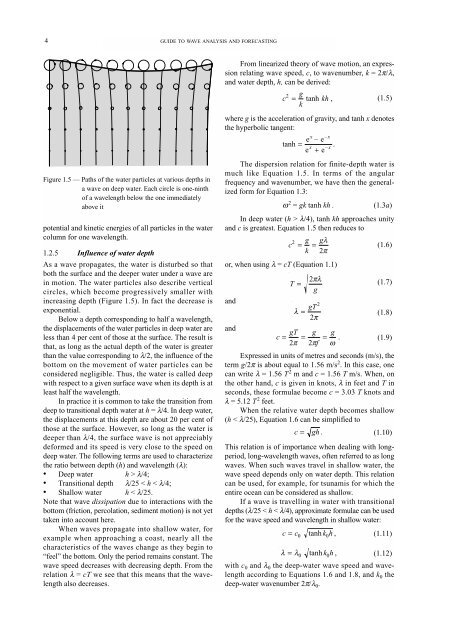GUIDE WAVE ANALYSIS AND FORECASTING - WMO
GUIDE WAVE ANALYSIS AND FORECASTING - WMO
GUIDE WAVE ANALYSIS AND FORECASTING - WMO
Create successful ePaper yourself
Turn your PDF publications into a flip-book with our unique Google optimized e-Paper software.
4<br />
Figure 1.5 — Paths of the water particles at various depths in<br />
a wave on deep water. Each circle is one-ninth<br />
of a wavelength below the one immediately<br />
above it<br />
potential and kinetic energies of all particles in the water<br />
column for one wavelength.<br />
1.2.5 Influence of water depth<br />
As a wave propagates, the water is disturbed so that<br />
both the surface and the deeper water under a wave are<br />
in motion. The water particles also describe vertical<br />
circles, which become progressively smaller with<br />
increasing depth (Figure 1.5). In fact the decrease is<br />
exponential.<br />
Below a depth corresponding to half a wavelength,<br />
the displacements of the water particles in deep water are<br />
less than 4 per cent of those at the surface. The result is<br />
that, as long as the actual depth of the water is greater<br />
than the value corresponding to λ/2, the influence of the<br />
bottom on the movement of water particles can be<br />
considered negligible. Thus, the water is called deep<br />
with respect to a given surface wave when its depth is at<br />
least half the wavelength.<br />
In practice it is common to take the transition from<br />
deep to transitional depth water at h = λ/4. In deep water,<br />
the displacements at this depth are about 20 per cent of<br />
those at the surface. However, so long as the water is<br />
deeper than λ/4, the surface wave is not appreciably<br />
deformed and its speed is very close to the speed on<br />
deep water. The following terms are used to characterize<br />
the ratio between depth (h) and wavelength (λ):<br />
• Deep water h > λ/4;<br />
• Transitional depth λ/25 < h < λ/4;<br />
• Shallow water h < λ/25.<br />
Note that wave dissipation due to interactions with the<br />
bottom (friction, percolation, sediment motion) is not yet<br />
taken into account here.<br />
When waves propagate into shallow water, for<br />
example when approaching a coast, nearly all the<br />
characteristics of the waves change as they begin to<br />
“feel” the bottom. Only the period remains constant. The<br />
wave speed decreases with decreasing depth. From the<br />
relation λ = cT we see that this means that the wavelength<br />
also decreases.<br />
<strong>GUIDE</strong> TO <strong>WAVE</strong> <strong>ANALYSIS</strong> <strong>AND</strong> <strong>FORECASTING</strong><br />
From linearized theory of wave motion, an expression<br />
relating wave speed, c, to wavenumber, k = 2π/λ,<br />
and water depth, h, can be derived:<br />
2 g<br />
c = tanh kh ,<br />
(1.5)<br />
k<br />
where g is the acceleration of gravity, and tanh x denotes<br />
the hyperbolic tangent:<br />
The dispersion relation for finite-depth water is<br />
much like Equation 1.5. In terms of the angular<br />
frequency and wavenumber, we have then the generalized<br />
form for Equation 1.3:<br />
ω 2 = gk tanh kh . (1.3a)<br />
In deep water (h > λ/4), tanh kh approaches unity<br />
and c is greatest. Equation 1.5 then reduces to<br />
2 g g<br />
c = = (1.6)<br />
k 2<br />
or, when using λ = cT (Equation 1.1)<br />
λ<br />
π<br />
and<br />
and<br />
e – e<br />
tanh =<br />
e + e<br />
T<br />
x – x<br />
x – x<br />
=<br />
g<br />
2πλ<br />
λ =<br />
π<br />
gT 2<br />
2<br />
gT g g<br />
c = = =<br />
2π 2πfω<br />
.<br />
(1.7)<br />
(1.8)<br />
(1.9)<br />
Expressed in units of metres and seconds (m/s), the<br />
term g/2π is about equal to 1.56 m/s 2 . In this case, one<br />
can write λ = 1.56 T 2 m and c = 1.56 T m/s. When, on<br />
the other hand, c is given in knots, λ in feet and T in<br />
seconds, these formulae become c = 3.03 T knots and<br />
λ = 5.12 T 2 feet.<br />
When the relative water depth becomes shallow<br />
(h < λ/25), Equation 1.6 can be simplified to<br />
c = gh.<br />
(1.10)<br />
This relation is of importance when dealing with longperiod,<br />
long-wavelength waves, often referred to as long<br />
waves. When such waves travel in shallow water, the<br />
wave speed depends only on water depth. This relation<br />
can be used, for example, for tsunamis for which the<br />
entire ocean can be considered as shallow.<br />
If a wave is travelling in water with transitional<br />
depths (λ/25 < h < λ/4), approximate formulae can be used<br />
for the wave speed and wavelength in shallow water:<br />
c = c0 tanh k0h, (1.11)<br />
λ = λ0<br />
tanh kh 0 , (1.12)<br />
with c0 and λ0 the deep-water wave speed and wavelength<br />
according to Equations 1.6 and 1.8, and k0 the<br />
deep-water wavenumber 2π/λ0. .

















